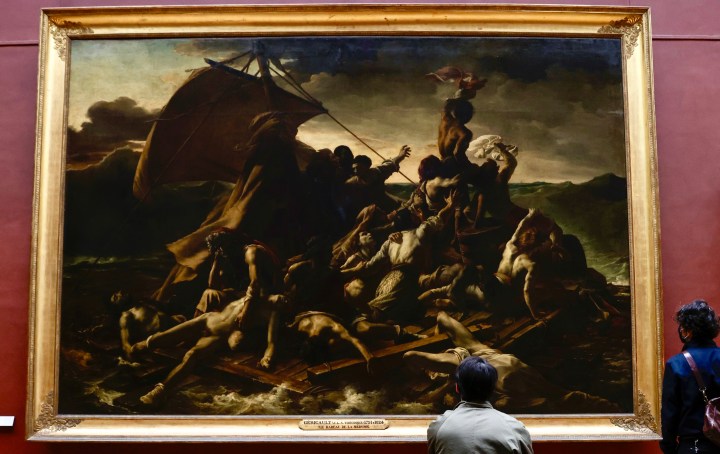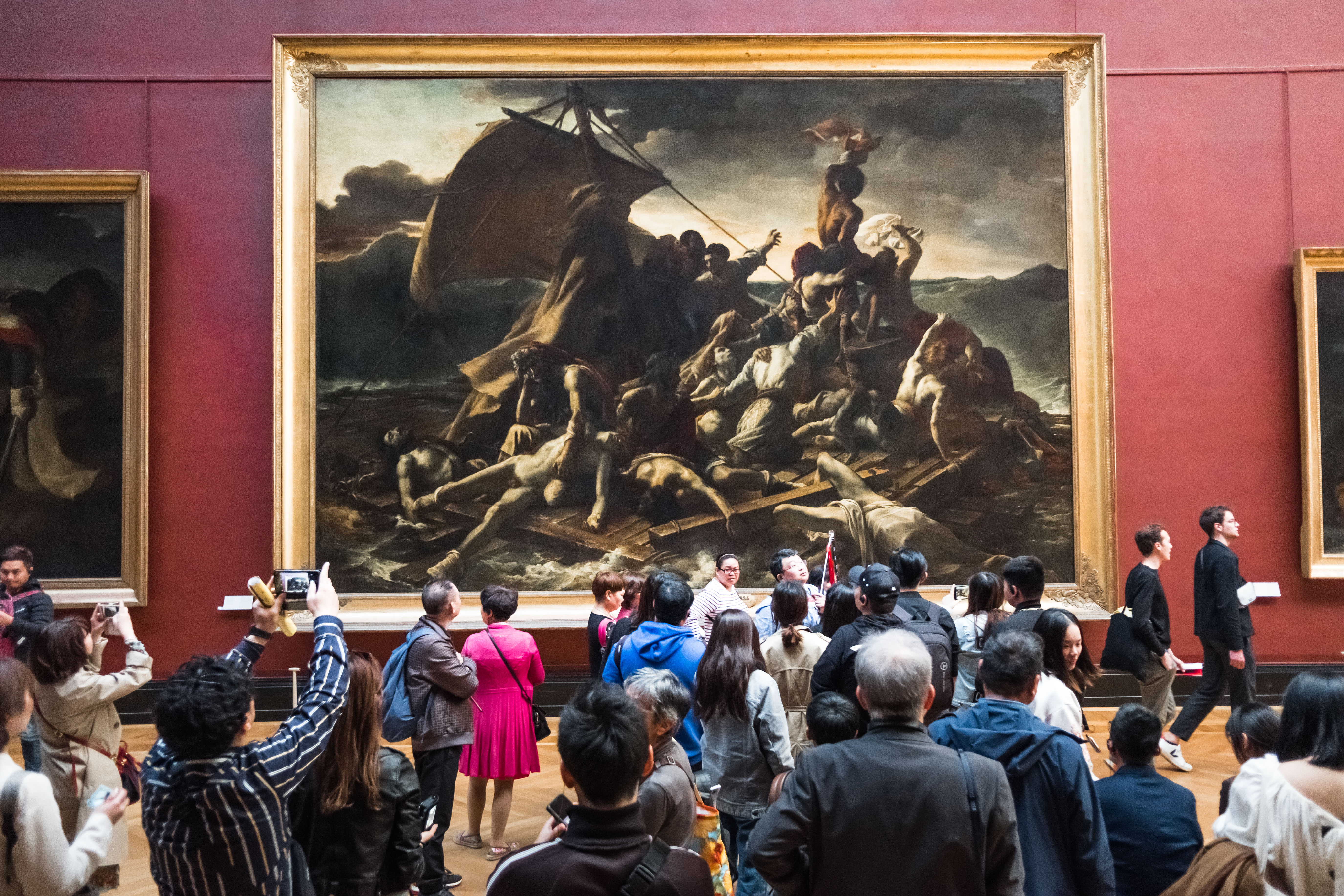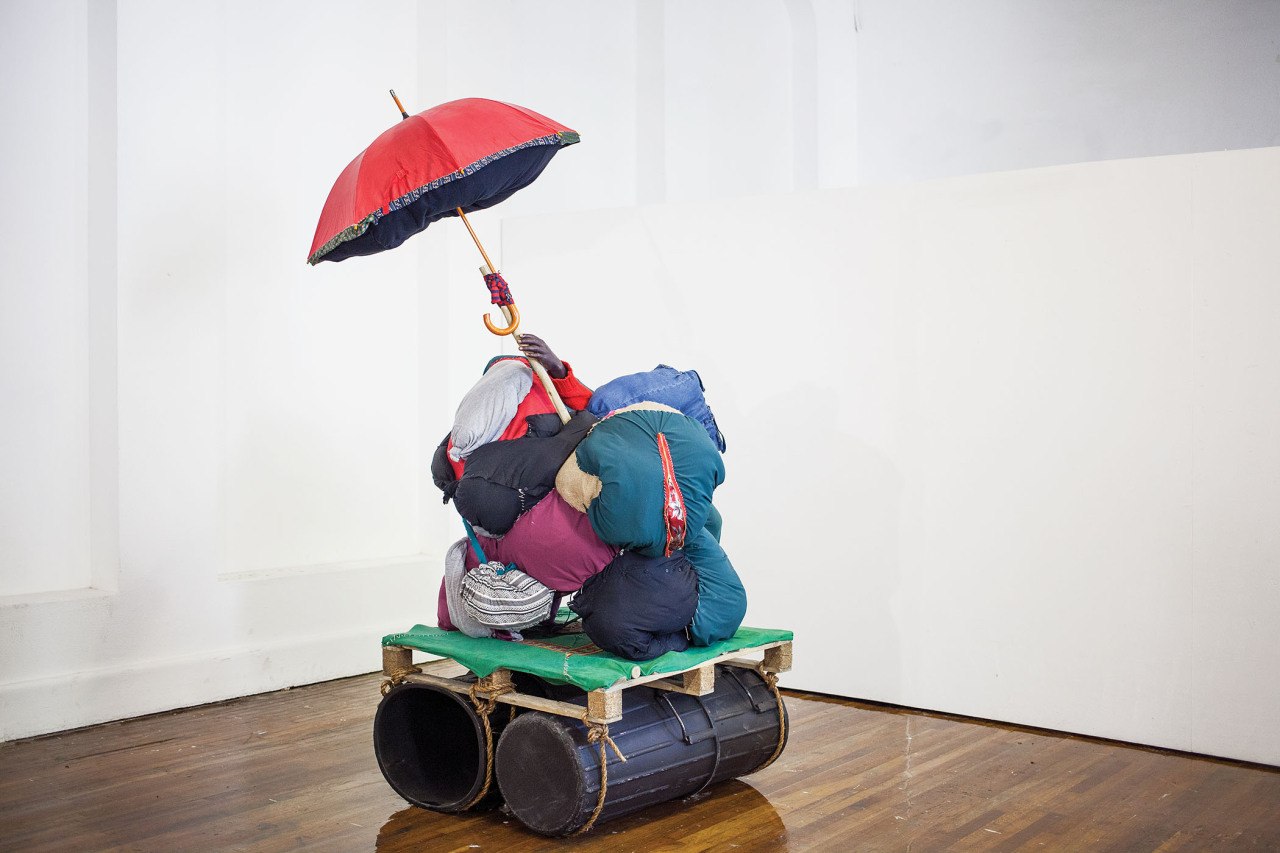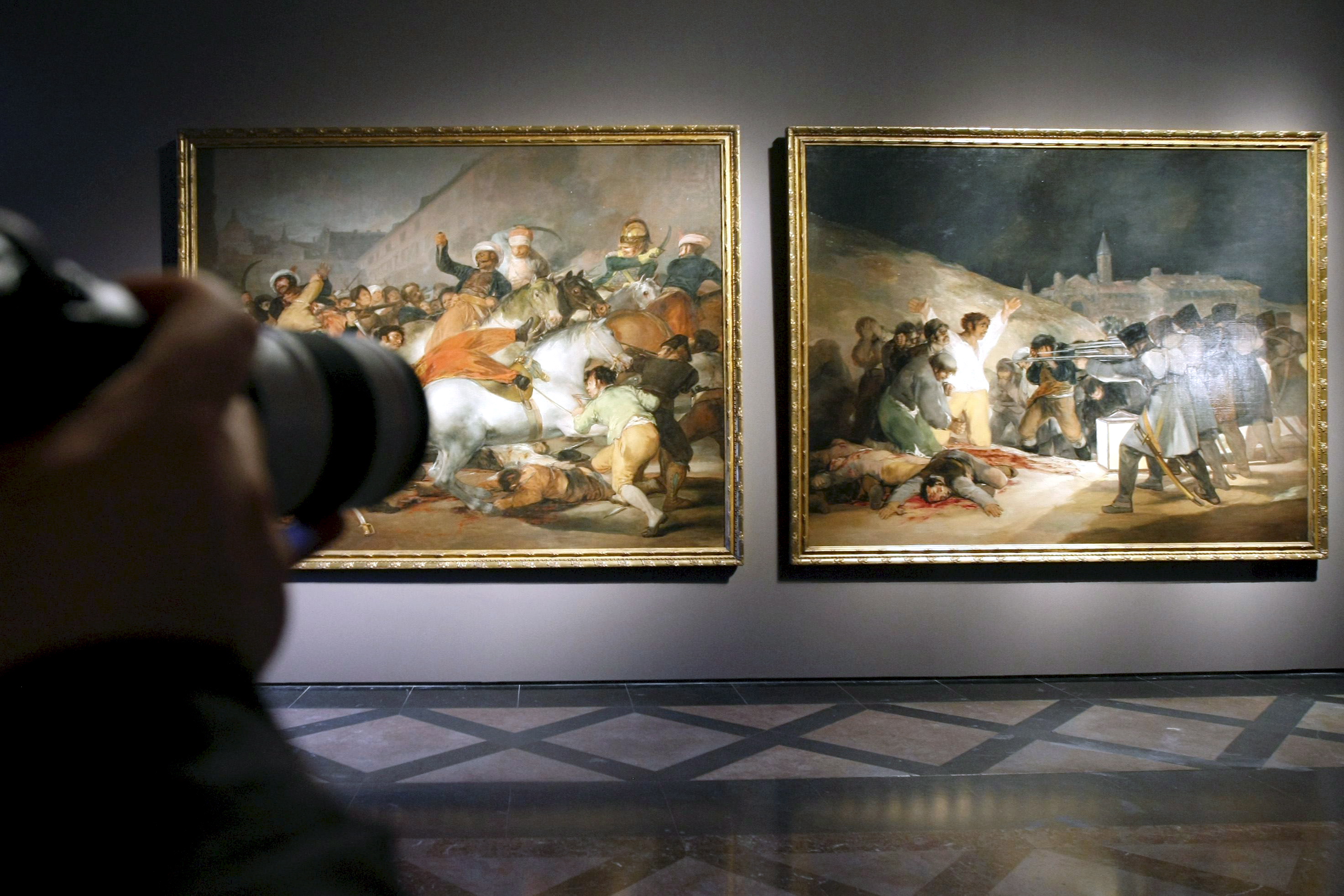MATTERS OF OBSESSION
The many extraordinary iterations of The Raft of the Medusa

‘We are all on The Raft of Medusa’ wrote historian Jules Michelet, contemporary of the 19th century Romanticist artist Théodore Gericault as he referenced a criticism against the French monarchy. Perhaps Michelet’s quote is a good opening for unpacking why certain historical paintings capture the imagination of famous contemporary artists from Frank Stella to Banksy.
Paintings like Gericault’s “The Raft of the Medusa”, Goya’s “The Third of May 1808” and Picasso’s ”Guernica”. And how with a tweak here and a twist there, from the sublime to the ridiculous they become as relevant to our present as they were to the past. While there are no figures indicating how many visit Museo Nacional del Prado in Madrid to see Goya’s “The Third of May 1808”, “The Raft of the Medusa” attracted 40,000 viewers in its day and for 19 years Guernica travelled the world.
Modern iterations use a variety of mediums including the chocolate drizzles of Vik Muniz, a driftwood reiteration by Marc Boulier, the veg iteration of Ju Duoqu, the tableaux vivants of Adad Hannah and the photographs by the anonymous artists that make up The Bruce High Quality Foundation referencing a deceased fictional artist named Bruce.

Tourists crowd and take pictures in front of French artist Jean-Louis Andre Theodore Gericault’s painting ‘The Raft of the Medusa’ at the French painting department of the Louvre Museum in Paris, France, 12 May 2019. EPA-EFE / CHRISTOPHE PETIT TESSON
Why certain paintings are chosen as opposed to others to be reconstituted by artists surely lies in the fact that these play out the ongoing drama of human nature and so remain pertinent even in current times. Dare I say, they have a universality?
And could these reiterations, reconstitutions or remaking of these famous historical paintings also be regarded as a sub-section of memes, that Ancient Greek-sounding term which is defined as a “self-replicating chunk of information” which is found on the internet but didn’t begin with the internet? In fact, some say they have been used for centuries.
Evolutionary biologist and author Richard Dawkins is given credit for introducing the term in the late 1970s in his book The Selfish Gene. According to Saint Hoax, meme creator extraordinaire, a meme has “the ability to capture insight in a way that is in complete alignment with the zeitgeist”. Its power lies in “its transmissibility and unique knack of being cross-cultural”.
As academic and author Simon Schama so aptly writes “if we want to sense the terror inflicted by bombing on civilians with unparalleled immediacy, we look at Picasso’s ‘Guernica’. If we feel the need to look at the unwatchable, say, a firing squad emptying their rifles on a civilian, we find our way to Goya’s ‘The Third of May 1808’. And if we want to see corruption, gross incompetence, fear of political reprisals and the total disregard for ordinary human life, look no further than ’The Raft of the Medusa’. 200 years later we are all still psychically adrift on that ’Raft of the Medusa.’”
It’s a quote that provides insight as to why a young South African art student, Simphiwe Ndzube was inspired by Gericault’s painting “The Raft of the Medusa” to create his own sculpture titled “Raft” exhibited at Iziko National Gallery in 2015. Especially considering that “The Raft of the Medusa” painting was executed 200 years ago, in a country almost 9,000 kilometers away and at a considerable cultural distance.

‘Raft’ by Simphiwe Ndzube, 2015. Image: Simphiwe Ndzube / Tumblr
Made from an assemblage of everyday utilities, Ndzube’s Raft is a deliberately precarious looking construction. It comprises a rough wooden palette on which, stuffed to bursting, are bundles of cloth; the palette rests on black refuse bins tipped on their sides. The disembodied black man’s arm emerging from the cloth bundles clutching a sun umbrella in Raft references the black man at the apex of “The Raft of the Medusa“ painting who waves a red cloth in the hope of attracting a rescue ship. Ndzube’s “Raft” may be a far cry from Gericault’s haunting historical oil painting but is no less powerful. Both works embody a metaphorical and literal cry for rescue.
There are many parallels between Gericault’s work with Ndzube’s “Raft”. In an interview with Perspectives, Ndzube explained that his departure for “Raft” was spaces — those in South African townships — and in particular his own coastal township Masiphumelele. He posited the idea of the township as a sinking raft. It’s one which operates both geographically and psychically. Masiphumelele is situated in a valley giving the impression of a sinking raft and like Gericault’s raft which was severed from the lifeboats, townships are dislocated places. A further parallel is with the violence that erupted on “The Raft of the Medusa” and that which is systemic to township living, was created in 2015 against a background of the global the migrant crisis.
The story of “The Raft of the Medusa” originally titled “Scene From a Ship Wreck” (to be less politically provocative) is a bleak one, and more about human suffering than a political statement. It’s one that touches on the age-old themes of societal inequalities, the fiscally and status privileged, power, incompetence and negligence of those in positions of power, fear of reprisal, and disregard for human life.
The painting is also indicative of a psychic shift in the narrative of the times. For in Gericault’s narrative there are no heroes, just survivors. Gericault could have depicted any one of the many highlights of this epic drama. Instead, he chose to paint a moment of polarity. Extreme hope in the shape of the Argus ship a mere speck on the horizon being waved at by a black man (suggesting the artist’s absolutionist sympathies) and extreme despair as the ship sailed on by.
“The Raft of the Medusa” is the story of an aristocratic captain who was appointed by the French king to captain a French frigate or a medium sized warship Medusa, carrying 400 souls including the French governor of Senegal. The captain’s inexperience — he hadn’t been to sea for 20 years — and his desire to make good time came at a price. The craft ran aground on the West African coast. Insufficient lifeboats meant the 147 remaining low-ranking passengers had to jump onto a life raft which was roped to a lifeboat. What became a metaphor of injustice was the captain’s decision to sever the rope between the lifeboat and the raft, setting it adrift for 13 days on rough seas during which time cannibalism, murder and insanity prevailed. This dark side of human nature was at strong odds with Rousseau’s prevailing philosophy that human nature is essentially good. Only fifteen of the 147 survived.
In preparation for the painting, the 27-year-old artist cut his hair like a supplicant on a spiritual path. And like a precursor of Stanislavski’s “method acting” turned his studio into a body farm with corpses from morgues and asylums, interviewed shipwreck survivors, watched dissections, studied stormy skies and seas, and constructed a detailed scale model of the raft to create a 4.91 m x 7.16m experience of such compelling and visceral intensity. The edge of the raft in the painting is pitched in such a way that the viewer feels that they are just a step away from entering the nightmare. Four years later Gericault was dead.

A man takes photos of (R-L) Goya’s paintings ‘Los Fusilamientos del tres de mayo’ (The Third of May 1808: The Execution of the Defenders of Madrid) and ‘El dos de mayo de 1808’ (The second of May 1808), alsow known as ‘La carga de los mamelucos’ (The Charge of the Mamelukes), after their restoration, at the Prado Museum in Madrid, Spain, 09 April 2008. EPA / FERNANDO ALVARADO
In response to the H1N1 pandemic in 2009, Adad Hannah photographed a version of “The Raft of the Medusa” with participants dressed in Hazmat type suits. The images were archived after the H1N1 pandemic receded but when Hannah revisited them in 2020 -right in the middle of the global Covid-19 pandemic he saw Gericault’s raft as “a rudderless vessel cut loose by those in charge and left to drift aimlessly and is once again a potent symbol of inept leadership and the human toll it takes”. In 2015, he was invited to Senegal to produce a work commemorating the 200th anniversary of the shipwreck. In response Hannah produced a series of tableaux vivants using pieces of dismantled pirogue boats and acres of blue cloth in which only Senegalese nationals featured as models, in complete contrast to the primarily white crew in the original painting.
Hannah explains that his tableaux vivants were a blend of the historical and the contemporary and his approach a re-contextualising the events on the raft. But rather than using a change of location he uses a time-related shift of 200 years. In so doing. Hannah draws attention to both the original tragedy of gross corruption and incompetence and its many parallels with contemporary events.
In the same year street artist and political activist Banksy also produced his own monochromatic stencil interpretation of “The Raft of the Medusa” titled “Refugees Waving to a Luxury Yacht”, created during Banksy’s time at the refugee camp in Calais. Perspicaciously painted on a wall a stone’s throw away from Calais’s immigration office, the tiny almost imperceptible rescue ship the Argus was replaced by a modern luxury sea craft which sails on by ignoring the shipwrecked survivors who waved desperately for help. The image was accompanied by the text “We’re not all in the same boat”. “Refugees Waving to a Luxury Yacht” criticises both Britain and France’s lack of support for the refugees and refers to the notorious “Jungle” refugee camp in Calais that housed thousands of refugees hoping to get to Britain. Two years later the owner finding the wall of the property too shabby, painted over the stencil.
Hu Jieming’s “Raft of the Medusa” draws a parallel to the suffering of millions of Chinese intellectuals during the Chinese Cultural Revolution. Jieming’s raft is constructed from soft drink bottles and littered with film cartons and fast-food packets, the garbage of consumer culture. In the center of his raft he depicts a European-style studio painter and his nude model surrounded by a chaotic mass of groups of contemporary Chinese teenagers and revolutionary forefathers.
A reproduction of “The Raft of the Medusa” is one of the paintings included in Jeff Koons’s 25 Gazing Ball Paintings (2015). Each painting has a blue glass “gazing ball” on a little shelf so that when viewers look into the ball and see their own reflections there is a feeling of having entered the painting. “This experience,” explained Koons “is about you: your desires, your interests, your participation, your relationship with this image.”
Peter Saul’s painting “Last Moments on the Raft of the Medusa” (2015) is a combination of sharp, dark humor and social commentary showing one figure swallowing pink intestines while feeding a raft-mate to the sharks. He was inspired by the “many wild anecdotes surrounding it”.
In 2019 Pascal Boyart, PBoy, created a mural on the wall of the roof of the former gold foundry of the Banque de France. In his interpretation the rafts sail is made of US dollars and his contemporary figures lie next to a smashed iPhone and a bottle of spilt prescription pills. As Simon Schama aptly writes, “For both artists the pathos and cruelty of abandonment functions as commentary on the injustices and inequalities of their times. There is a damning continuity between indifference to the plight of those fleeing destitution and war, and the moral squalor of a glamorous art world awash with money.”
As Colombian-born artist Doris Salcedo writes, “Art doesn’t rescue… What art can do is create an emotional connection that communicates the victim’s experience. It’s as if the victim’s destroyed life, cut short at the time of the murder, might or could in some way continue within the spectator’s experience.”
And genius is not about predicting the future but being able to convey the zeitgeist of the present with such acuteness that it takes our breath away. Taken one step further, it’s the ability of the painter to still move us hundreds of years down the line so that we pay homage to whether it’s in a flippant or serious way by responding with an interpretation of the original. DM/ ML
In case you missed it, also read A stitch in sacred time – exhibition weaves our oceans back into the realm of the divine
A stitch in sacred time – exhibition weaves our oceans back into the realm of the divine
Visit Daily Maverick’s home page for more news, analysis and investigations


















Comments - Please login in order to comment.